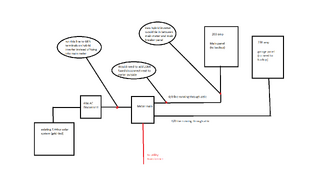jonjon09
New Member
Hey all, I have been patiently waiting for my electrician to install my 200 amp fused disconnect so that I can get my 18k and 2 powerpros going. Very excited, already did the firmware update while waiting (got delivered over a month ago after already waiting a few months for the delivery to begin with, my patience is being tested lol).
I have a few questions before he (hopefully) comes by next week to install. I have 2 200 amp main panels running off 2 separate 4/0 lines from the meter main outside. No existing disconnect for those. I also have existing solar panels with micro-inverters and existing 60A disconnect so I plan to re-route that line into the GEN terminal on the 18k instead of being tapped into the 4/0 line at the meter main. See rough diagram below that I drew for my electrician months ago.
Questions:
1. Should I just connect the CT clamps to the line for the main panel that will be backed up since I don't think I can manage to get the clamp around both 4/0 wires and have no plans to use the 18k to tie into the 2nd garage 200 amp panel? I saw the other thread that mentioned monitoring both for another user but I don't see how I could manage that? The garage panel is high non-essential loads (tankless water heater, Tesla wall charger, irrigation pump)
2. My electrician seems convinced that I also need a disconnect switch (non-fused) for the garage 200 amp panel despite it not being tied to the 18k or any other solar/batteries. Is that a NEC requirement? Drives up my cost but if needed I understand for safety reasons... Not much room on the outside wall for it both.
3. Is there a problem with the way I am running the wiring as shown in the rough diagram to the main 200 amp panel? Not really using any kind of tap as mentioned in the EG4 manual but it seems fine based on the Sol-Ark wiring diagram... Running new 4/0 wires from the meter main -> 200 amp fused disconnect -> GRID terminals on 18k and relocating the existing 4/0 wire (that is currently tying the meter main to the main 200 amp panel) directly to the LOAD terminals in the 18k.
TYIA.

I have a few questions before he (hopefully) comes by next week to install. I have 2 200 amp main panels running off 2 separate 4/0 lines from the meter main outside. No existing disconnect for those. I also have existing solar panels with micro-inverters and existing 60A disconnect so I plan to re-route that line into the GEN terminal on the 18k instead of being tapped into the 4/0 line at the meter main. See rough diagram below that I drew for my electrician months ago.
Questions:
1. Should I just connect the CT clamps to the line for the main panel that will be backed up since I don't think I can manage to get the clamp around both 4/0 wires and have no plans to use the 18k to tie into the 2nd garage 200 amp panel? I saw the other thread that mentioned monitoring both for another user but I don't see how I could manage that? The garage panel is high non-essential loads (tankless water heater, Tesla wall charger, irrigation pump)
2. My electrician seems convinced that I also need a disconnect switch (non-fused) for the garage 200 amp panel despite it not being tied to the 18k or any other solar/batteries. Is that a NEC requirement? Drives up my cost but if needed I understand for safety reasons... Not much room on the outside wall for it both.
3. Is there a problem with the way I am running the wiring as shown in the rough diagram to the main 200 amp panel? Not really using any kind of tap as mentioned in the EG4 manual but it seems fine based on the Sol-Ark wiring diagram... Running new 4/0 wires from the meter main -> 200 amp fused disconnect -> GRID terminals on 18k and relocating the existing 4/0 wire (that is currently tying the meter main to the main 200 amp panel) directly to the LOAD terminals in the 18k.
TYIA.



